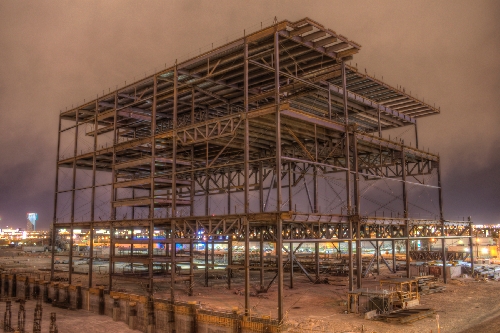Photo exhibit examines Las Vegas unfinished projects, abandoned dreams

Dreams deferred. Progress postponed. Aspirations abandoned.
Tomorrow … canceled.
Overwrought, perhaps, but not an inaccurate summation of “To the Neon Gods They Made,” a photo exhibit at the Winchester Cultural Center Gallery that stares straight at what Las Vegans will likely never see as once envisioned: grand construction projects, intended as new jewels glittering on our skyline from Las Vegas Boulevard to the ‘burbs, now stalled or scrapped altogether, slain by the Great Recession.
“As the economy boomed, a new casino was always opening, and it was so much fun to see a new casino, but as we explored the city, we’d notice that the signs were out of date,” recalls photographer Tony Flanagan, who relocated from Wisconsin to Las Vegas in 2008 and teaches photography at Henderson’s Coronado High School. “It would say, ‘Opening in spring 2009’ and here it was spring 2010. That was glaring, that something was supposed to be here and it’s not.”
That tough reality led Flanagan to team with fellow shutterbug Michael Monson for the 12-photo collection. Often majestic in their towering dignity, they are still sobering images of lonely, half-dressed edifices, unmanned cranes and scaffolding idling nearby, unrealized sidewalks still rows of rubble.
Among them: Manhattan West condos, CityCenter’s elliptical Harmon Hotel, Vantage Lofts, the St. Regis Residencies, Echelon Place and the Fontainebleau.
Regret and neglect may be an initial reaction on first viewing, but Monson finds beauty in these construction castoffs. “To some people they are an eyesore, but we wanted to photograph them in a way that makes them beautiful so we can look at them in different ways,” says the Elko-born Monson, who teaches English and creative writing at Spring Valley High School.
“Instead of them being failures, let’s look at them as art. If they were finished, they would be these big, beautiful megaresorts or condominiums, so we wanted to show them in a beautiful light as opposed to something that was sad.”
Shot at night, the black backdrops add ironic emphasis, as if darkness has not only made its nightly appearance, but has also fallen on the fate of these projects. “We’re a city that looks better at night,” says Flanagan, who with Monson used the ambient glow of the Strip’s bright lights and sharpened the photos via HDR (high-dynamic range) imaging, taking the pictures at five different exposures and pulling out the best of each to create a perfect exposure.
“We have so many lights around us here, why not use the light currently in existence instead of flashes?”
Borrowing a lyric from Simon & Garfunkel’s classic “Sounds of Silence,” the exhibit’s title underlines a kind of visual silence — as well as the literal silence of stilled cranes and muted jackhammers — that has gripped these buildings, most sadly frozen in their skeletal stage.
“We’re a city that really believes in our neon gods, we put a lot of faith and trust that they will keep the city going,” Monson says. “It’s ironic that this is a display of what our gods were never able to be.”
Contact reporter Steve Bornfeld at sbornfeld@ reviewjournal.com or 702-383-0256.